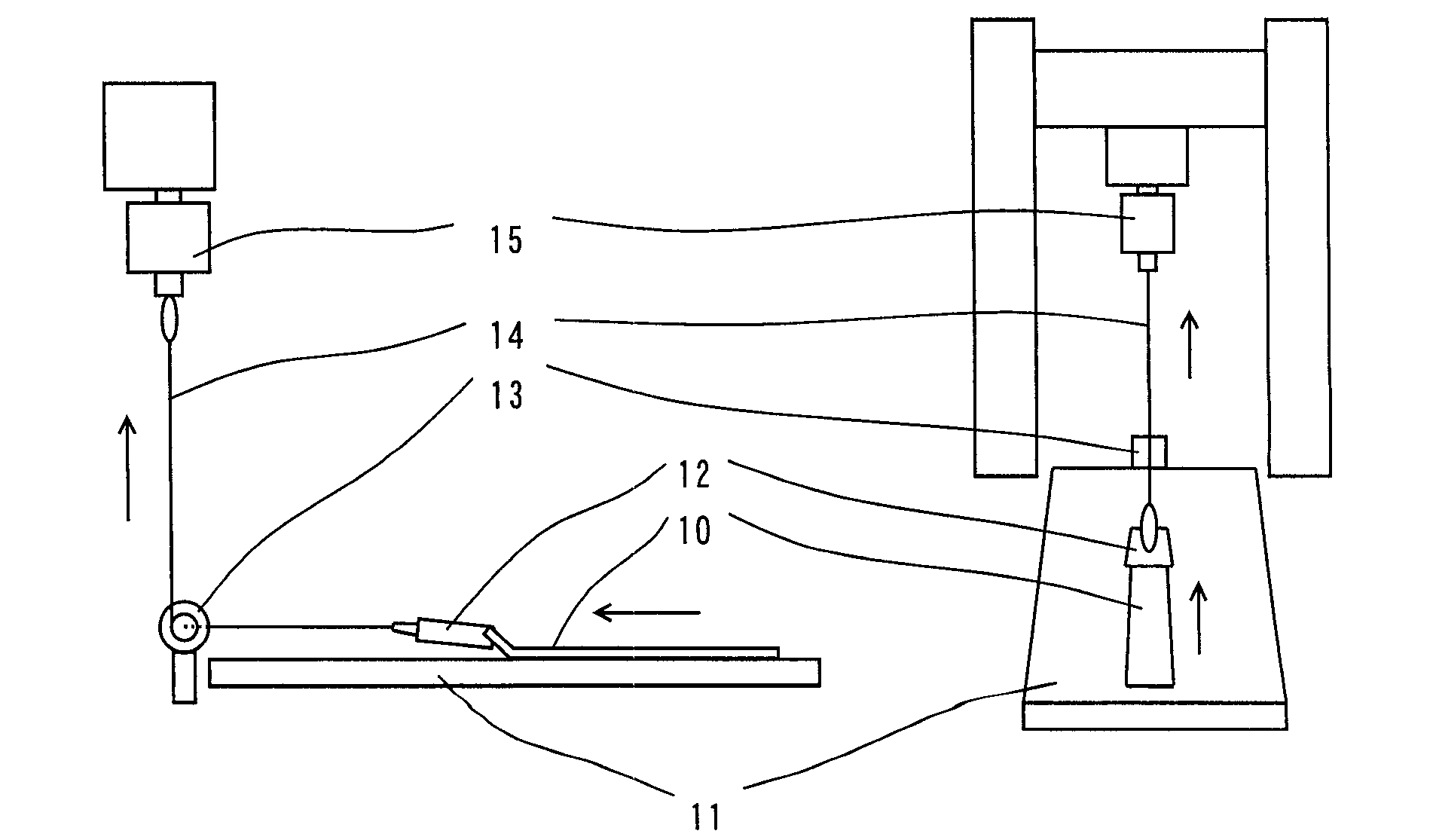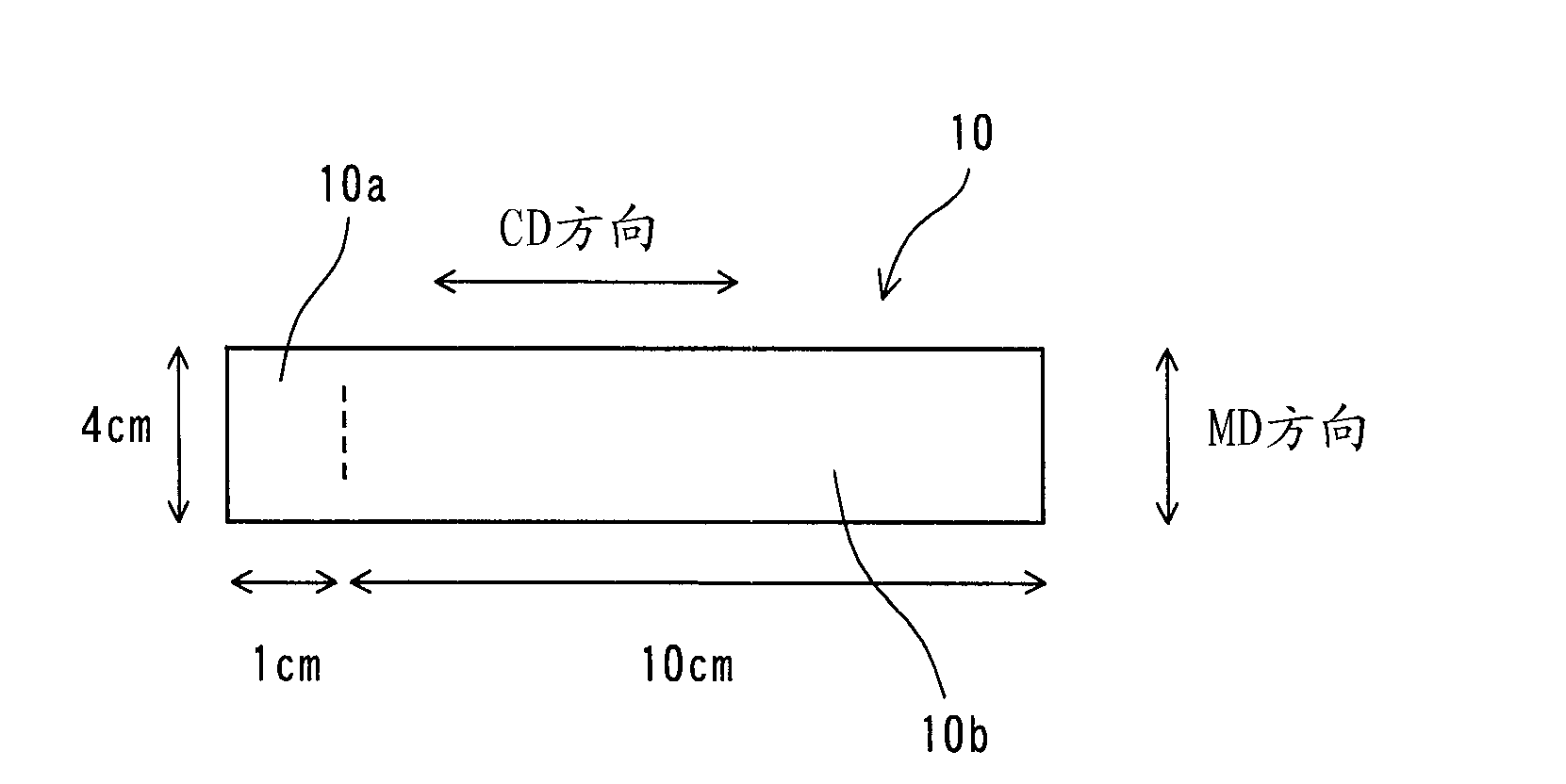Laminated sheet, and process for production thereof
A technology of laminating sheets and sheets, applied in the direction of layered products, pharmaceutical formulations, transportation and packaging, etc., can solve problems such as peeling or slippage, user discomfort or dissatisfaction, and achieve excellent adhesion and adaptability , small itching irritation, improved adhesion and adaptability
- Summary
- Abstract
- Description
- Claims
- Application Information
AI Technical Summary
Problems solved by technology
Method used
Image
Examples
Embodiment 1
[0150] By using general melt-blown production equipment, the melt-blown method has a spinning temperature of 260°C, an air temperature of 270°C, an air pressure of 0.4 MPa, a discharge of 0.2 g / hole·min, and 400 spinners in the cotton inlet. 100 parts by mass of polypropylene resin (MFR = 1100 g / 10 minutes) was spun under the number of holes (arranged in rows), and the resulting fibers were collected on a rotating mesh conveyor as a support to produce a fiber with 5 g / m 2 A fabric basis weight of the melt-blown nonwoven fabric sheet, and then the sheet is taken up.
[0151] Forty (40) parts by mass of rayon fibers and 60 parts by mass of polyester fibers are homogeneously blended, and then produced in the usual manner with 60 g / m 2 A semi-random carded web of fabric basis weight. The carded web was placed on a perforated drum support with an open area ratio of 25% and a hole diameter of 0.3 mm. The carded web was continuously moved in its longitudinal direction at a speed ...
Embodiment 2
[0156] The basis weight of the semi-random carded web is 40 g / m 2 , except that, in the same manner as in Example 1, a compound with 45 g / m was obtained 2 The basis weight of the hybrid nonwovens. For the resulting nonwoven fabric sheet, the thickness ratio of the liquid retaining layer to the adhesive layer one (1) was 8.7. In addition, the fibers of the adhesive layer comprising the meltblown nonwoven fabric in the obtained nonwoven fabric sheet had a number average fiber diameter of 2.57 μm and a standard deviation of fiber diameter distribution of 1.318, and a coefficient of fluctuation of fiber diameter was 51.26%. Furthermore, in the resulting nonwoven fabric sheet, the liquid retaining layer had a void ratio of 93.3%, and the adhesive layer had a void ratio of 88.6%.
[0157] The sheet was dipped in a cosmetic preparation, and the adhesiveness of the sheet was measured. As in Example 1, the adhesiveness of the sheet with the impregnation rate of 500 mass % was higher...
Embodiment 3
[0160] By using general melt-blown production equipment, the melt-blown method has a spinning temperature of 280°C, an air temperature of 290°C, an air pressure of 0.4 MPa, a discharge of 0.3 g / hole·min, and 400 spinners in the cotton inlet. 100 parts by mass of poly(butylene terephthalate) resin (MFR=90 g / 10 min) was spun under the number of holes (arranged in rows), and the resulting fibers were collected on a rotating net as a support Conveyor to produce 20 g / m 2 Melt-blown nonwoven sheet of fabric basis weight, and the sheet is taken up.
[0161] In the same manner as in Example 1, an entangled web (nonwoven fabric) was produced by using 40 parts by mass of rayon fibers and 60 parts by mass of polyester fibers. With 20 g / m 2 The previously produced melt-blown nonwoven fabric sheet of fabric basis weight is uncoiled with an unwinding device and then superimposed on the fiber web. The sheet and the fiber web are placed on a completely flat support with fine mesh, and move...
PUM
| Property | Measurement | Unit |
|---|---|---|
| diameter | aaaaa | aaaaa |
| diameter | aaaaa | aaaaa |
| density | aaaaa | aaaaa |
Abstract
Description
Claims
Application Information
 Login to View More
Login to View More - R&D
- Intellectual Property
- Life Sciences
- Materials
- Tech Scout
- Unparalleled Data Quality
- Higher Quality Content
- 60% Fewer Hallucinations
Browse by: Latest US Patents, China's latest patents, Technical Efficacy Thesaurus, Application Domain, Technology Topic, Popular Technical Reports.
© 2025 PatSnap. All rights reserved.Legal|Privacy policy|Modern Slavery Act Transparency Statement|Sitemap|About US| Contact US: help@patsnap.com



